
Spirit of the Masters
The USA GOJU Federation lineage is diverse and complex. Chojun Miyagi, the founder of GOJU was known as Fingers Charlie. The three other men in the top row from left to right were Peter Urban’s (the founder of USA Goju) major martial arts influences and senseis. Gogan Yamaguchi The Cat who founded GOJU KAI in Japan. Masutatsu Oyama God Hand or Buddha Hand, the creator of Kyokushin and Richard Kim, who was given the name Guiding Light by his students. Kim was not a Goju practitioner but was Peter Urban’s main sensei throughout his life and taught Master Urban most of his Kobudo or weapons technology. Urban studied directly under all three of these masters.
Master Peter Urban The Lion, the founder of USA GOJU brought Goju to America. The initials USA originally meant Urban Systems of America and later transitioned to mean United States of America.
To the right of Urban is Edward Verycken, The Iron Wolverine. He was Urban’s number one student who passed down many of the katas in the USA Goju system.
Joe Hess Lion Paw was a student of Urban and Verycken and the founder of American Tactical Goju.
Master Joseph Kelljchian has two names; The Rock and The American Bushido is the Grand Master of the the USA GOJU Federation. He studied under Joe Hess and then directly under Peter Urban and was given Hall Number 25 or the 25th dojo in the USAGA.
Master Robert Lasorsa Steadfast Fire studied under Grand Master Kelljchian and he trained many black belts in the USAGF.
Master David Schopp, Staunch Fox is the head sensei of the Fox Dojo. His sensei is Master Lasorsa and was given the Hall number 40 of the USAGF. Since Master Kelljchian’s hall number is 25 the Fox Dojo has the number 25-40 meaning that this is the 40th dojo under Grand Master Kelljchian.
The Fox Dojo is represented by the image in the center of the Shrine Wall. The image depicts the face of the Fox and the Volcano. The Volcano is the name Master Schopp gave to his Dai Sempai (number one student), Sensei Andrew Proctor.
From the Beginning
Goju Ryu karate had its origins in the Fukien Province, China.
In the late 1800’s, Master Kanryu Higashionna (1853-1917) brought the art known as Shorin Ryu to the island of Okinawa. After training for a time in Chinese Boxing, Master Higashionna developed a self defense system called Naha-Te; a combination of Naha (an Okinawan city), and Te (a bare-handed fighting technique).
Goju was Formalized in Okinawa, Japan.
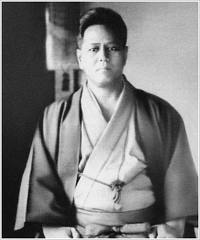 One of the master’s famous students, Chogun Miyagi (1888-1953), studied with the Master for 14 years while in Okinawa. Later on he traveled back to Fukien Province for additional study. Miyagi returned to Okinawa in 1917, about the time of Master Higashionna’s death. Miyagi then further modified the art, adding katas, and formalizing the system.
One of the master’s famous students, Chogun Miyagi (1888-1953), studied with the Master for 14 years while in Okinawa. Later on he traveled back to Fukien Province for additional study. Miyagi returned to Okinawa in 1917, about the time of Master Higashionna’s death. Miyagi then further modified the art, adding katas, and formalizing the system.
Realizing that the theory of a “One Strike Kill” would not be well accepted in the educational programs of the day, Sensei Miyagi began developing an art that combined soft movements (breathing katas) with dynamic tension exercises (hard movement). In this manner, karate was used not only for spiritual enlightenment, but for exercise, and for self defense.
Around 1930, Master Miyagi also gave the style the name, Goju, (meaning ‘hard-soft style’). This is one of the first systems possessing the name not denoting it’s place of origin.
Among Master Miyagi’s better known students are: Seiko Higa, Seikichi Toguchi, Meitoko Yagi (the recognized leader of the Mei Buken school of Okinawan Goju) and:
Gogen Yamaguchi.
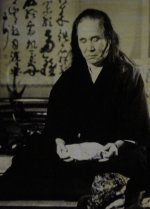 Yamaguchi (1909-late 1980’s) was affectionately called “THE CAT” because his hair was like that of a lion and had what was known as ‘Neko Myogi” (Cat Stare). This was a stare that could not be broken. He inspired the term “Cat Style” out of the stance he made famous (Neko Ashi Dachi).
Yamaguchi (1909-late 1980’s) was affectionately called “THE CAT” because his hair was like that of a lion and had what was known as ‘Neko Myogi” (Cat Stare). This was a stare that could not be broken. He inspired the term “Cat Style” out of the stance he made famous (Neko Ashi Dachi).
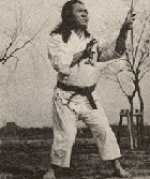 Master Yamaguchi’s association with Master Miyagi proved to be a fruitful one, as he was named successor of the Goju Mantel in Japan. In the mid 60’s, Yamaguchi was successful in unifying all karate dojos into what was then the All Japan Karatedo Organization. Ultimately, Yamaguchi evolved his own personal style called GOJU-SHINTO. Yamaguchi added some Taikioku Katas to the Goju curriculum, to help guide students to the advance stages of the Goju Kata.
Master Yamaguchi’s association with Master Miyagi proved to be a fruitful one, as he was named successor of the Goju Mantel in Japan. In the mid 60’s, Yamaguchi was successful in unifying all karate dojos into what was then the All Japan Karatedo Organization. Ultimately, Yamaguchi evolved his own personal style called GOJU-SHINTO. Yamaguchi added some Taikioku Katas to the Goju curriculum, to help guide students to the advance stages of the Goju Kata.
Peter Urban
1953 was also the year a young sailor was introduced to karate in Yokohama, Japan. His name was Peter Urban (August 14, 1934 – April 7, 2004). Peter Urban is credited with training some of the greatest martial arts traditionalist in this generation. Master Urban, while stationed in Japan for eight years with the united States Navy, trained with Prof. Richard Kim, an authority of Okinawan Karate Systems. Prof. Kim introduced Peter Urban to Masters Yamaguchi (Japanese Goju) and Mas Oyama (Kyokushin Kai). Yamaguchi accepted him as a student. In 1957, Peter Urban opened a small Dojo in Tokyo, and competed in the all-Japan College Championships that same year. In 1959, Urban moved to America, and opened his first American Dojo, in Union City, N.J. The following year, he opened another school on 17th street in Manhattan.
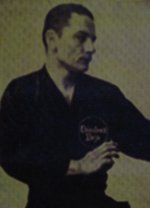 Peter Urban was reportedly one of the men responsible for establishing structured tournaments in America, one of the first of those being the North American Karate Championships in 1962, held at Madison Square Garden. Three years later, at the age of 31, Urban’s first book; The Karate Dojo, was published. Urban opened his famous Chinatown Dojo in 1967, making Japanese karate open to the public.
Peter Urban was reportedly one of the men responsible for establishing structured tournaments in America, one of the first of those being the North American Karate Championships in 1962, held at Madison Square Garden. Three years later, at the age of 31, Urban’s first book; The Karate Dojo, was published. Urban opened his famous Chinatown Dojo in 1967, making Japanese karate open to the public.
In the early 1970’s, Urban returned to Japan to ask Gogen Yamaguchi the permission to establish an independant karate system in America. Yamaguchi refused, saying the rules of Bushido stated that no white man could achieve Nirvana. Urban, dissatisfied with the decision, retorted that these same rules stated that Japan could never lose a war. This statement offended the Sensei. Realizing this, Urban prepared to follow the samurai custom to cut off his pinky finger in apology.
He was stopped by Yamaguchi’s oldest son. However, the damage was done. Urban returned to America, and incorporated himself as the founder of American Goju.
Master Joseph Kelljchian
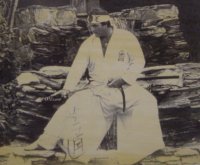 In the 1970’s, Master Joseph Kelljchian began his Goju training with Peter Urban. He earned his shodan rank from Master Joe Hess and his Masters Degree from Peter Urban. He has trained and taught throughout the United States and internationally in Mexico, Ecuador, South America and Puerto Rico.
In the 1970’s, Master Joseph Kelljchian began his Goju training with Peter Urban. He earned his shodan rank from Master Joe Hess and his Masters Degree from Peter Urban. He has trained and taught throughout the United States and internationally in Mexico, Ecuador, South America and Puerto Rico.
Master Joseph Kelljchian, the “American Bushido, is a tenth degree black belt and founder of the United States of America Goju Federation. (U.S.A.G.F.) For over two decades, he has been the chief instructor for numerous karate schools in South Florida, as well as across the country and is has produced over 140 Black Belts.
Master Kelljchian has received many awards for his outstanding martial arts achievements. He has appeared in magazines, newspapers and on television for his accomplished techniques and fighting abilities. In addition, he has taught self-defense and survival skills to many United States police academies /departments, as well as the U.S. Department of Justice, Drug Enforcement Administration.
He is the author of Beginning Karate, One Woman Every Minute
and Classical Chokes.
Master Robert Lasorsa
Robert Lasorsa, , 9th Dan, USA GOJU Karate, began his martial arts training in 1980 and received his Shodan promotion in 1984 from Master Joseph Kelljchian, 10th Dan USA GOJU Federation. He has, in turn, trained and promoted many karateka from beginner to masters’ level. Under the guidance and direction of Master Kelljchian, Master Lasorsa has dedicated his Karate training to the betterment and growth of the ryu.
“When I was a kyu sitting in front of Master Kelljchian, who at that point in his Goju career was a Nidan, he would say to us students, “My dream is to create ten black belts, who then create ten black belts, who then create ten, and so on.” That was 1980.
I was motivated by Master K’s spirit, as fortunately were a few of my dojo brothers and sisters, and I did create fifteen black belts, all from the white belt level, giving no credit for any previous training or rank. Three of those dans became disciples and achieved a master level. When they had the required time in their rank and the display of an appropriate character, all of these students performed in ryu sponsored examinations, dan or master, both written and physical, in order to be awarded accredited promotions.
I always go with quality, not quantity. I hope that the lessons passed down from the Spirit of the Masters allows these students to continue to grow and succeed in the Way of Goju Karate.
I have given one honorary dan rank in my life to recognize a deserving woman, who advocates for our youth who have mental illness.
I look back upon the years and the love from the ryu and I am Proud to be a Martial Artist. Thank you Master K.”
Master Lasorsa believes that the Karate virtue “one must obey the laws of reality, in life as in death” is the most important of all of the Karate virtues. All other virtues interact with this.
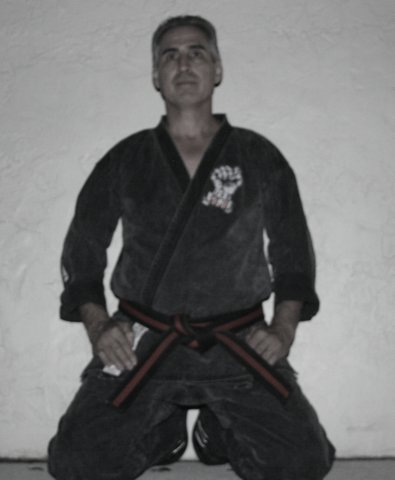 Master Lasorsa is a true martial artist and he applies his Karate to all aspects of his life. He recognizes that through careful and balanced study, karateka develop a deeper understanding of what is truly valuable and ultimately learn to live happier lives. The only thing that one can control is life is ones attitude.
Master Lasorsa is a true martial artist and he applies his Karate to all aspects of his life. He recognizes that through careful and balanced study, karateka develop a deeper understanding of what is truly valuable and ultimately learn to live happier lives. The only thing that one can control is life is ones attitude.
Two of Master Lasorsa’s favorite rules to live by are; “In Karate, as in life, one must understand that to get something you must be willing to give up something”, and “when in doubt, courtesy bow”.